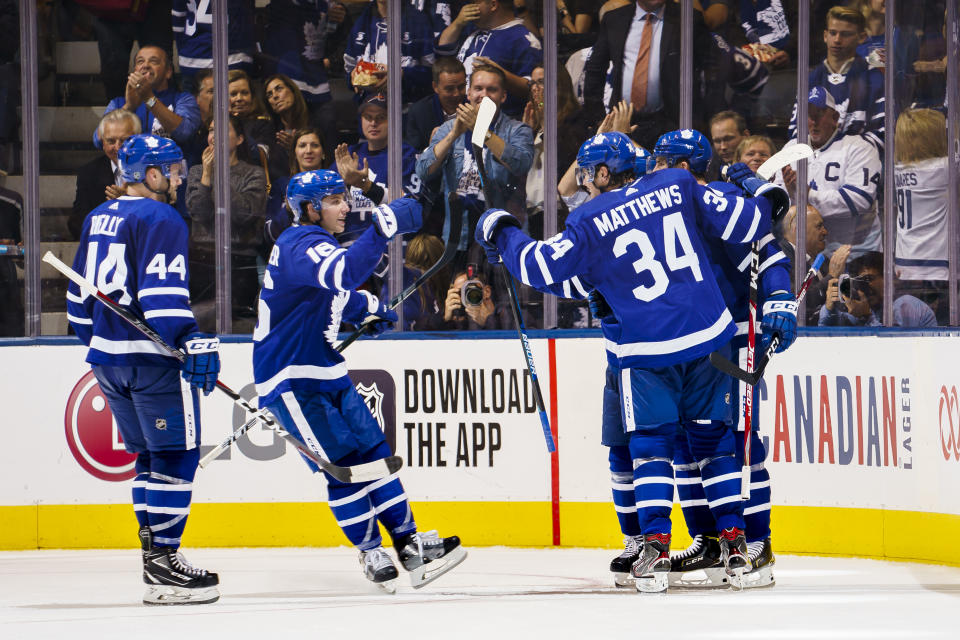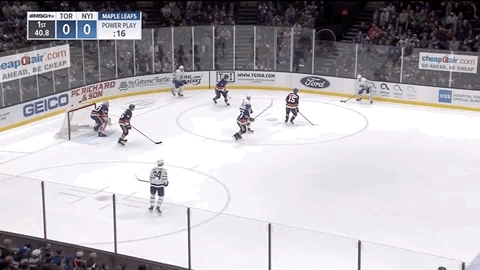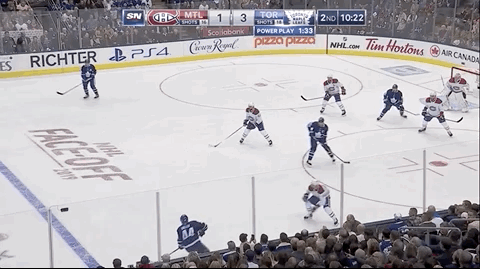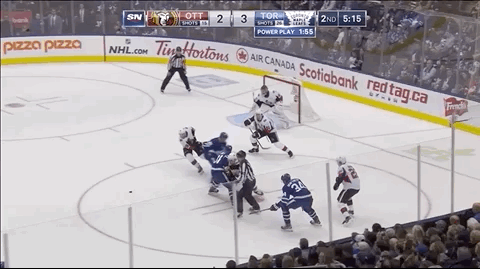Maple Leafs' power-play adjustments showing early promise

The Toronto Maple Leafs, as currently constructed, are supposed to ice a dominant first power-play unit.
Whether they will or not isn’t clear yet, but when you send out a group with three forwards who each cost more than $10 million quarterbacked by a defenceman who racked up 72 points last year you expect greatness. This team has allocated its resources to be top-heavy and skill-heavy. Those are two qualities that tend to correlate with 5-on-4 success.
Toronto has been successful with the man advantage, going 4-for-15 so far, but more encouraging than that small sample size production is how the fundamental adjustment they made to the first unit is working. Last season, the Maple Leafs had Morgan Rielly at the point, Mitch Marner and Auston Matthews on the right and left walls respectively, Nazem Kadri working the “bumper” spot, and John Tavares in front of the net. That group spearheaded a power-play success rate that was eighth in the league at 21.8 percent and tended to run hot and cold.
While their results weren’t too shabby, there were some cracks in the design. Kadri gave the team very little in the bumper role, putting up just 13 power-play points while the rest of the unit had at least 19 each. Tavares was arguably overqualified for the net-front presence gig. Because neither of the guys on the walls were playing their off wing, the one timer was virtually off the table.
Although the cast of characters is virtually identical this time, the structure is different with only Rielly retaining identical responsibilities. Tavares is now the bumper, Matthews and Marner have switched sides and sole newcomer Andreas Johnsson has taken up residence by the net.
The shakeup has made the whole group more dangerous for three reasons:
1. Marner is now a threat to shoot
While Marner’s creative passing is his greatest offensive asset, when opposing goaltenders and defenders have to honour his shot he becomes far more of a headache for them.
Playing on the right side last season, Marner ended up taking more than his fair share of harmless shots when he couldn’t find a cross-ice pass. Shooting is never the worst play you can make, but it’s not a surprise that he scored just three goals on 42 shots when many of them were deflection fodder that looked like this:

Since he’s been moved to the off wing, Marner’s shot has been unlocked. In the Maple Leafs’ opening game against the Ottawa Senators, he drilled the post with the kind of wheel-and-shoot maneuver that wouldn’t have been possible for him from the right.

About ten seconds prior to that play, Marner ripped a full one-timer - which is awfully rare for him, but a handy tool to have at the ready.

This power play is not going to thrive through feeding Marner for shot after shot, but he can help the group diversify its attack.
2. Tavares is a major bumper upgrade
The role of bumper requires precision passing prowess and premium hockey IQ. Tavares has both of those in spades. Although Kadri is a fine player, the Maple Leafs captain is a different animal. While his new job may mean fewer power-play goals - and possibly even points - for the 29-year-old, he can thrive as a facilitator who creates opportunities for others.
Marner’s first goal of the season, for instance, came on the sort of short-area give-and-go Tavares will be participating in a lot this season.

That may look easy, but Tavares’s grace in traffic is impressive and he sets Marner up perfectly for the game’s opening goal.
Perhaps the nicest play the veteran centre made in this vein didn’t result in a goal, but gave Matthews the kind of open net he rarely misses.

It’s not like Kadri never made nifty plays like these last year, but it feels like a safe bet to assume Tavares can do it with more consistency, which will make the whole unit less reliant on Marner as a distributor.
3. Auston Matthews is primed to take the next step
Matthews’ power-play ice time and usage has been a hotly debated topic in Leafs circles for years, but last season he got full first-unit run and largely delivered. His 12 power-play goals were good for 12th in the NHL, despite missing 14 games to injury and ranking 144th among forwards in time with the man advantage. That kind of efficiency is borne out of his potent shot, one the Maple Leafs are looking to feature more prominently this year.
Because Matthews can score from basically anywhere, the move from one wing to another for him may be less significant than Marner, but it still looks like it’s going to move the needle, primarily because it opens up one-timer possibilities - like the one that went down as the game-winner in Toronto’s opener.

Opening up that possibility doesn’t mean he’s putting his famous wrister on the shelf, either. When he has time and space he’s still able to stick handle and let it fly with his deceptive release.

Having two equally viable options from the right dot makes Matthews a solid bet to top his 12 power-play markers from last season. There also seems to be a concerted effort to feed him, as his seven shots with the man advantage rank first on the team and second in the NHL behind Brent Burns. It’s too early to make much of that stat, but the young centre was 33rd in power-play shots last season and the Maple Leafs would probably like to see him climb those rankings.
Just three games in, it’s impossible to make confident proclamations about the state of this power play, but the changes that have been implemented seem logical in theory and look promising in action. Of course, this adjustment presents a couple of risks as well. Marner and Matthews will be less effective fighting on the boards on their off wings and Johnsson will be hard-pressed to replicate Tavares’s net-front production from last season. Those considerations aren’t insignificant, but right now they don’t look like they’re going to outweigh the positives.
The pieces have long been in place for the Maple Leafs to be a team opponents really don’t want to take a penalty against. Now it seems like the team might have the structure to match.
More Maple Leafs coverage from Yahoo Sports Canada

 Yahoo Sports
Yahoo Sports 



